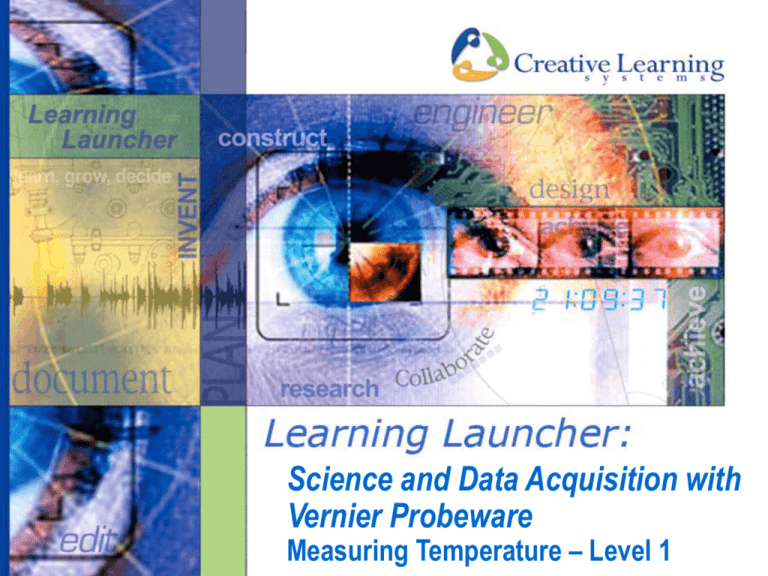Measuring Temperature with Vernier Probeware
advertisement

Science and Data Acquisition with Vernier Probeware Measuring Temperature – Level 1 © Creative Learning Systems www.creativelearningsystems.com What You’ll Learn… How to use Vernier temperature sensors How to use the Vernier LabQuest interface How to use Vernier Logger Pro software to record and analyze scientific data How to conduct experiments using the scientific method How experimental variables affect temperature Stuff You’ll Need… Vernier temperature probe “Beaker” for water Vernier LabQuest interface Computer with Logger Pro software Vernier experiment activity sheets Vernier, LabQuest and Logger Pro are all registered trademarks of Vernier Software and Technology © Creative Learning Systems www.creativelearningsystems.com Before you continue… Go back to ShawSTEMLab.weebly.com and download the Word Document entitled 01 A Hot Hand Save this document into your group’s file. On this Word document is where you will answer all the questions from this PowerPoint and record your observations and notes for this experiment. Vernier, LabQuest and Logger Pro are all registered trademarks of Vernier Software and Technology © Creative Learning Systems www.creativelearningsystems.com Research/Documentation… Ensure that you are writing everyday about what you do and accomplish. Formulate a hypothesis before you begin to record data. What do you think your experimental data will reveal? Remember – it doesn’t matter whether your hypothesis is right or wrong, only that you have a hypothesis to test. Hypothesis must be in an If/Then format Describe each step of your experiment. Record all of your experimental data. Take photographs (print screens)of your experiment. Answer the questions that follow each activity. © Creative Learning Systems www.creativelearningsystems.com Rewrite and answer these questions on the document you downloaded from the STEM Lab Website • • • • • • Where does the word ‘thermometer” come from? Who invented the earliest temperature sensors? What is a Thermoreceptor? What does a Thermoreceptor regulate? Where are Thermoreceptors located? What software do you use to record your data? © Creative Learning Systems www.creativelearningsystems.com What You Should Know… Who cares about temperature? …EVERYBODY!!!! Hardly a day goes by when we don’t measure temperature one way or another. We measure temperature with sensors called thermometers. The name comes from the Greek words thermo, meaning temperature and meter, meaning measure. © Creative Learning Systems www.creativelearningsystems.com What You Should Know… Since measuring temperature is so important, scientists and inventors have developed many types of temperature sensors. You probably know that most substances expand when they get hot and contract when they get cold. Inventors began exploring ways to measure this effect as early as the 11th century. One of the earliest temperature sensors to use this principal was invented by Galileo in the 16th century. This is the same principle that is used in the mercury and alcohol thermometers that are still in common use. Galileo Thermometer Mercury Thermometer © Creative Learning Systems www.creativelearningsystems.com What You Should Know… Modern technology has brought us many, many new ways to measure temperature. We can now measure temperature using electronic sensors, infrared scanners and liquid crystals just to name a few. The type of sensor you’ll be using for the activities in this Learning Launcher is called a thermistor. Thermistors were invented by Samuel Ruben in 1930. A thermistor uses electrical resistance to measure temperature. Thermistors are most commonly used in the digital thermistat you may use to control temperature in your home. Thermistor Vernier Thermistor-based Temperature Probes There’s still one very important type of temperature sensor we haven’t discussed yet. One that you use every single day. Can you guess what it is? Flip to the next slide to find out… © Creative Learning Systems www.creativelearningsystems.com What You Should Know… …YOU!!! Or, more specifically, a special type of nerve cell called a thermoreceptor. In mammals such as humans, thermoreceptors are concentrated in the skin. But there are also thermoreceptors that regulate your internal systems. One type of thermoreceptor responds to cold and another responds to heat. Together, they’re what make you sweat when you’re hot and seek shelter or grab a sweater when you’re cold. And they trigger emergency sensory alarms when you come in contact with extreme hot or cold temperatures! Can you imagine trying to survive without these sensitive temperature sensors providing your body with a constant stream of data? © Creative Learning Systems www.creativelearningsystems.com What You Should Know… The Scientific Method You’ve studied the scientific method before in your Science classes. But, before we start to use our Vernier probeware to collect data, let’s review it one more time: 1. State the question you intend to answer through your research and experimentation. 2. Form a hypothesis – a prediction of what you think you’ll find. -If/Then format 3. Test your hypothesis by doing an experiment or study. 4. Analyze your results. 5. Draw a conclusion and report your findings. Be sure to capture all of these steps in your Word Document © Creative Learning Systems www.creativelearningsystems.com What You Should Know… The activities in this Learning Launcher use the Vernier temperature probe, the LabQuest interface and Logger Pro software on your computer. Temperature Probe LabQuest Interface © Creative Learning Systems www.creativelearningsystems.com What You Should Know… Now let’s explore the Logger Pro software. It’s what you’ll use to record and analyze your experimental data. Launch Logger Pro software. Then under the File menu, click Open and select the Middle School with Vernier folder. Click on “01 Hot Hand”. Ensure the temperature is in Celsius. Follow the directions for the experiment on the document you downloaded from the STEM Lab Website. © Creative Learning Systems www.creativelearningsystems.com Do It! As you plan your activity and conduct your experiment, you may come up with interesting questions or ideas to explore about temperature. That’s great! After you’ve concluded the experiment, you may create your own experiment. Be sure you follow the steps of the Scientific Method! 1. 2. 3. 4. 5. 6. State your Question Formulate a Hypothesis (If/Then format) Design your experiment Observe and Collect Data Analyze Data State your conclusion © Creative Learning Systems www.creativelearningsystems.com


